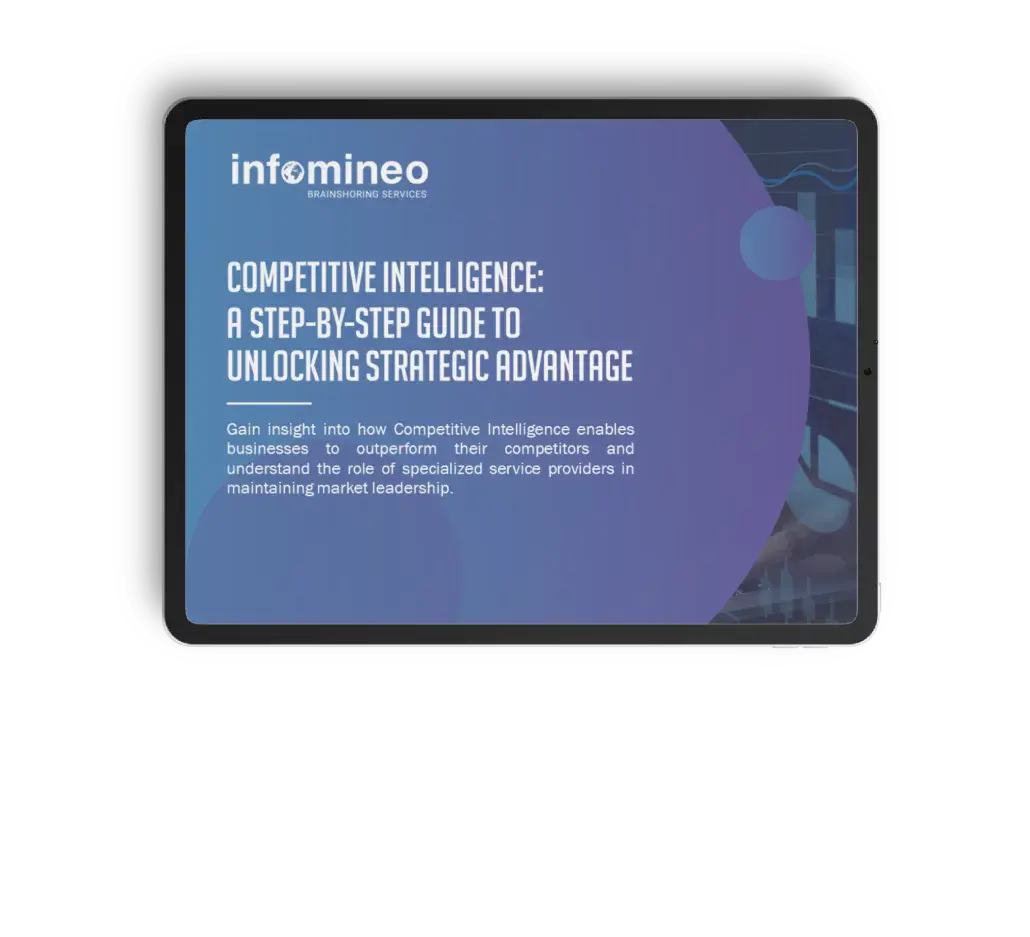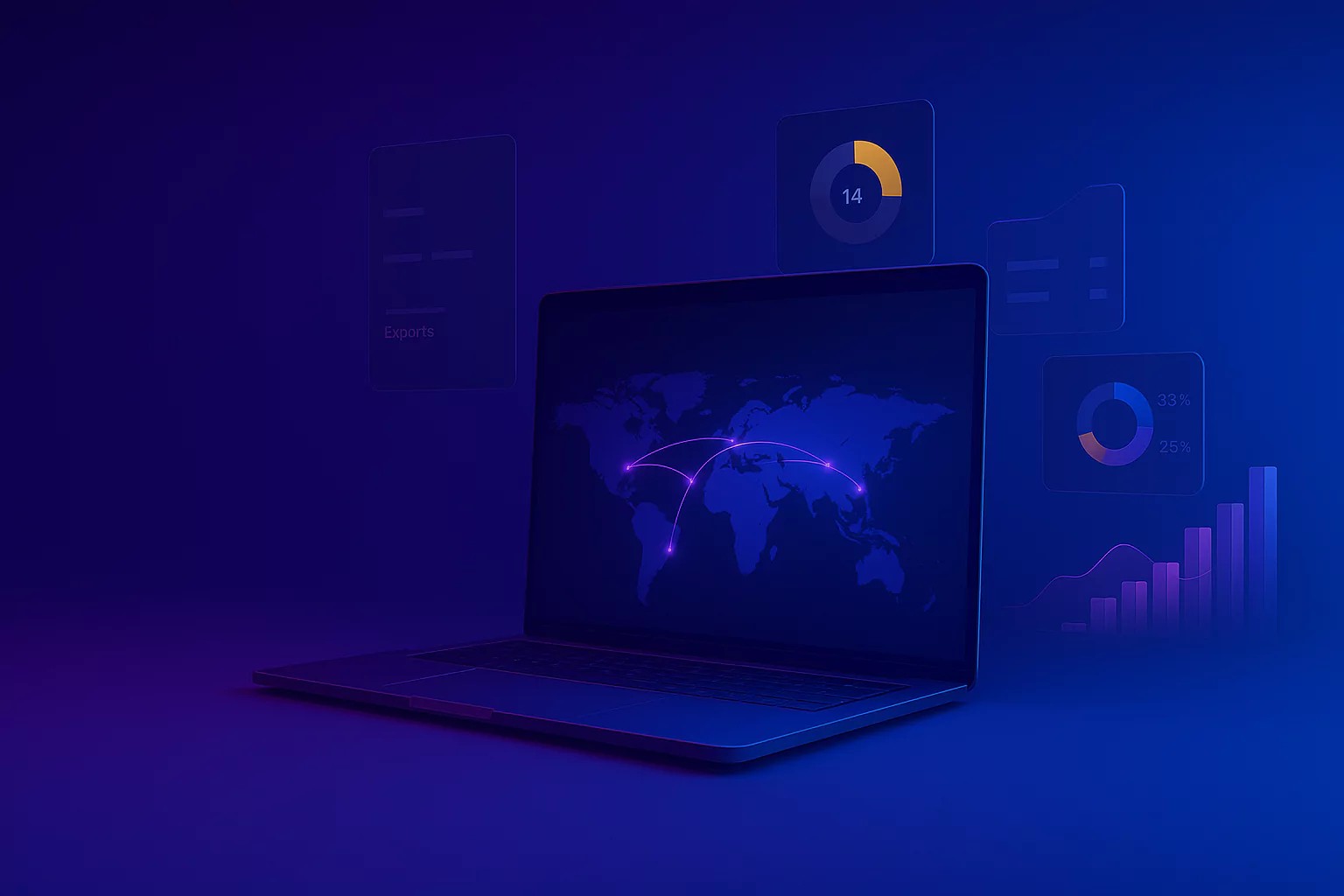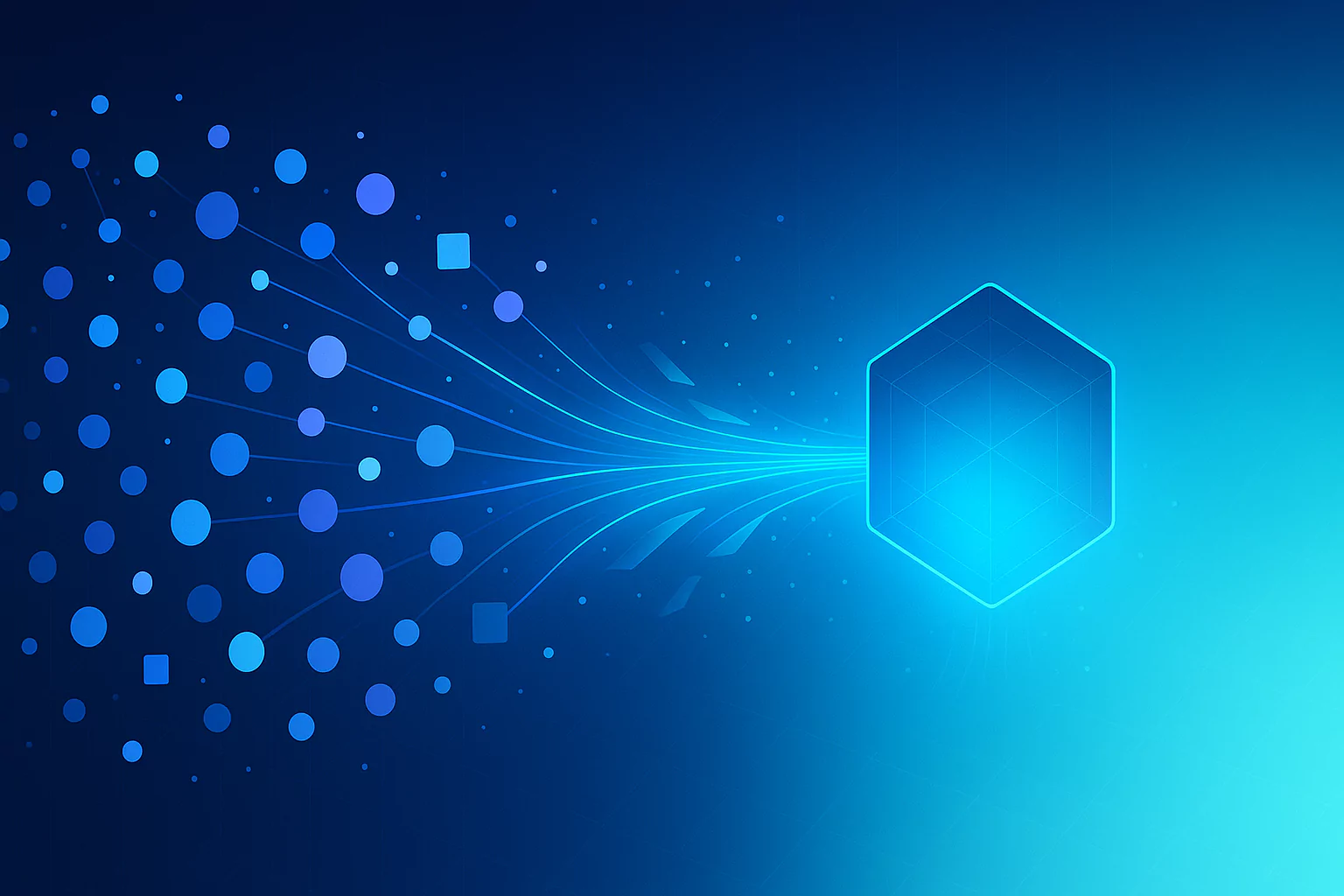Unveiling the Power of Competitive Intelligence Solutions: Use Cases and Forward-looking Trends
Unveiling the Power of Competitive Intelligence Solutions: Use Cases and Forward-looking Trends
In today’s highly competitive and saturated markets, the role of information, data, and technology has become paramount for businesses to gain a strategic advantage. As the volume and complexity of data continue to grow, traditional information-gathering methods are proving to be increasingly time-consuming, inefficient, and outdated.
Unlock Competitive Insights
Learn about our structured framework in our ebook on Competitive Intelligence
Gain Competitive Edge
To stay ahead of the competition, companies must leverage the latest technologies that allow them to analyze large amounts of structured and unstructured data from a wide range of sources. By combining these technologies with business acumen, companies can gain a comprehensive understanding of their competitive landscape and make informed decisions that drive growth and innovation.
Introduction
Competitive intelligence (CI), also known as corporate intelligence, involves collecting, analyzing, and using market and customer data to maintain a competitive advantage. It also examines market trends and disruptors, allowing companies to stay agile and responsive. Competitive data is provided through CI solutions such as Semrush, Similarweb, Moz, and others.
Types of Competitive Intelligence
Competitive intelligence can be divided into two main categories, which are tactical intelligence and strategic intelligence. Tactical intelligence is focused on short-term goals and aims to provide actionable insights that can be implemented to drive immediate results. It is often used to inform decisions related to capturing market share, increasing revenues, and responding to specific competitor actions.
On the other hand, strategic intelligence takes a long-term view, focusing on industry trends, technological advancements, and potential disruptors. It informs high-level strategic decisions, such as entering new markets, developing new products, and adapting to changing industry dynamics. Its insights help companies anticipate and prepare for challenges and opportunities that may impact them in the future.
By combining both tactical and strategic intelligence, companies can develop a comprehensive understanding of the competitive landscape and make informed decisions that position them for success in the short and long term.
Benefits of Competitive Intelligence
Competitive intelligence goes beyond gathering readily accessible data but rather requires deep analysis based on multiple sources. Once this data is gathered, the benefits of incorporating competitive intelligence into business strategies are many. Below are a few examples:
- Obtaining Competitive Insights: Tracking competitor performance, products, services, and customer reviews helps businesses understand their market position, strengths, and areas for improvement to adjust their strategies and stay ahead of the curve.
- Predicting Competitive Behavior: Businesses can anticipate the behavior of their competitors and develop strategies to stay one step ahead of the competition.
- Tracking Industry Trends: By tracking market trends, businesses can predict future patterns, technology disruptors, and consumer preferences. Accordingly, they can capitalize on rising opportunities and swiftly respond to any rising threats.
Data-backed competitive insights help businesses prioritize resources, optimize processes, refine and improve strategies, and streamline decisions. With the fast-evolving market dynamics and increasing competition, CI is no longer an option or luxury but rather a necessity.
Competitive Intelligence Use Cases
The widespread adoption of competitive intelligence across various industries underscores its impact and strategic importance. From competitive benchmarking to supply chain management and more, below are the different applications of CI:
Competitive Benchmarking
CI solutions could be used when conducting a competitive benchmarking exercise. For example, traffic analysis tools can help monitor the online performance of competitors through bounce rates, clicks, interactions, and other relevant metrics. This data should be complemented through secondary research, looking into their market shares, financial performance, products and services, communication channels, and more. These could be extracted from competitor websites, industry reports, financial databases, news, and more, leveraging web scraping tools whenever extracting large amounts of data. This comprehensive approach would allow businesses to assess their relative strengths and weaknesses and identify potential opportunities.
Product and Service Development
By recognizing emerging trends and consumer preferences, businesses can align their product and service offerings with the evolving needs and wants of their target market. This proactive approach allows companies to anticipate shifts in consumer expectations and behavior, enabling them to develop products and services that resonate with their audience. This, in turn, would foster customer loyalty and promote company growth.
Marketing and Advertising
Through competitive intelligence, companies can gain insights about their competitors’ marketing strategies, advertising techniques, and online activities. These include information on how they position their products and services in the market, the messaging they use to attract customers, and the channels they leverage for advertising. This data would enable them to adapt and refine their own marketing and advertising strategies to stay up-to-date with market trends.
Supply Chain Management
Analyzing competitors’ supply chains can provide key insights that help companies enhance their procurement processes, negotiate better terms, and ensure a stable supply of raw materials, leading to increased productivity and cost reduction. This strategic use of CI enables companies to drive continuous improvement in their supply chain processes, leading to enhanced operational efficiency.
Risk Management
By closely monitoring competitor actions and market trends, businesses can identify potential threats and develop contingency plans to mitigate them. This would allow them to swiftly respond to unforeseen events and minimize their impacts on business operations and continuity. Examples of such risks include shifts in economic conditions, technological advancements, and changing consumer behavior. Diversifying suppliers to mitigate supply chain disruptions could also be one strategy to minimize the potential impacts of operational risks.
Exploring Emerging Trends in Competitive Intelligence Solutions
The competitive intelligence landscape is changing, driven by shifting market dynamics and technological advancements. Several key trends are shaping the future of CI solutions, redefining how organizations gather, analyze, and leverage data.
Innovative Tech Solutions
Aside from traffic analysis and web scraping tools, CI uses advanced technologies, including the following:
| Technology | Description |
|---|---|
| Artificial Intelligence (AI) | Machine learning algorithms help analyze extensive datasets, uncovering insights and patterns that would be challenging or impossible to find otherwise. Business entities can leverage AI to automate data collection, analysis, and reporting, allowing companies to focus on strategic activities. |
| Natural Language Processing (NLP) | NPL enables computers to understand, generate, and manipulate human language, whether in the form of text or speech. Businesses leverage it to extract and analyze unstructured data from various sources, including social media, client reviews, and news articles. |
| Big Data Analytics | By leveraging big data analytics, companies can analyze large and complex data sets and identify correlations that uncover key market or industry insights. |
| Data Visualization Tools | Data visualization facilitates the identification of patterns, trends, and anomalies within datasets, as well as the illustration and communication of insights. |
| Cloud-based Competitive Intelligence (CI) | Cloud-based competitive intelligence enables applications and software to operate on a virtual network, eliminating the expenses and time required for physical hardware installation. |
Shift from Tactical to Strategic Intelligence
A prevalent trend among companies using competitive intelligence is the shift from a predominantly tactical focus to a more strategic one. Teams are now gathering strategic CI data on long-term market dynamics, customer insights, and changes in the business environment to understand all factors affecting their businesses. In comparison, they previously focused on tactical CI, analyzing mainly competitors and short-term market dynamics. Merely understanding competitors is no longer sufficient, and companies are looking to have a comprehensive understanding of the market to be able to plan for success.
Scaling CI to all teams
Companies are more and more recognizing the value of scaling CI solutions across teams rather than limiting their application to the marketing and sales departments. This approach ensures that every team has the necessary information to improve their processes based on market changes, achieve their targets, and drive growth. This collaborative effort fosters cross-team knowledge sharing and encourages the use of CI.
Need for Additional Resources
As businesses increasingly use CI, they need to allocate additional budget, manpower, resources, and overall capacity to effectively collect and leverage the gathered data. Skilled professionals are essential for deriving actionable insights from CI data. This can be enabled through training programs to equip employees with the required skills and maximize CI’s potential.
Driving Success through Competitive Intelligence Tools and Strategic Market Insights: Infomineo’s Comprehensive Model
Our business research department has extensive expertise in utilizing competitive intelligence tools alongside primary and secondary research to evaluate and enhance our clients’ online presence, e-commerce strategies, operations, and supply chains. We employ cutting-edge tools, including traffic analysis tools to gauge brand popularity and monitor both organic and inorganic traffic, bounce rates, and other relevant metrics.
This data is further enriched by web scraping solutions that extract detailed information on products, services, and competitors, complemented by thorough secondary research to analyze market size, demographics, and more.
This holistic approach ensures a comprehensive understanding of the market landscape, enabling us to provide strategic insights and recommendations that drive success for our clients.
FAQs
What Is Competitive Intelligence (CI)?
Competitive Intelligence refers to the ethical collection, analysis, and usage of data regarding customers and markets. This data could be collected from both secondary research sources such as industry reports, financial databases, and news, as well as from CI solutions, which are platforms that provide competitor data.
What Are the Potential Benefits of Incorporating CI Solutions into Your Business Strategy?
The benefits of incorporating CI solutions into your business processes and strategy are many. Some of them include gathering insights into your competitors’ performance and market position and predicting their behavior to adjust your strategies. Others include tracking market trends to capitalize on rising opportunities and identify potential threats, optimizing resource allocation and processes, and guiding strategic decisions to stay ahead of the competition.
What Are Some Common Applications for CI?
CI could be used as part of a competitive benchmarking exercise to assess your strengths and weaknesses compared to your rivals and identify opportunities to capitalize on. It also helps identify risks and prepare contingency plans, develop products and services based on consumer insights, enhance marketing strategies and advertising techniques, and optimize supply chains to boost productivity and reduce costs.
How Is Technology Reshaping CI Solutions?
CI uses advanced technologies that are changing how data is gathered and presented. You can leverage AI to automate data collection, analysis, and reporting; Natural Language Processing (NLP) to extract and analyze unstructured text or audio data from various sources; big data analytics to study large and complex data sets; data visualization tools to identify patterns and communicate insights; and cloud-based CI to eliminate the expenses and time required for physical hardware installation.
How Does Strategic CI differ from Tactical CI?
Strategic CI refers to comprehensive market data that captures long-term dynamics, customer insights, industry trends, and technological advancements, while tactical CI focuses mainly on competitors and short-term market dynamics.
Conclusion and Key Takeaways
By gathering insights into competitor performance, market trends, and customer preferences, organizations can make data-backed decisions, optimize processes, and capitalize on emerging opportunities. CI data can be applied to a wide range of business functions, from competitive benchmarking and risk management to product development and supply chain optimization. By leveraging innovative technologies and shifting toward comprehensive and strategic CI, businesses can streamline their processes, gain deeper insights, and make more informed decisions that will boost their growth.









